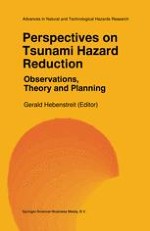1997 | OriginalPaper | Buchkapitel
Tsunami Detection and Warning Capability Using Nearshore Submerged Pressure Transducers — Case Study of the 4 October 1994 Shikotan Tsunami
verfasst von : David D. McGehee, James P. McKinney
Erschienen in: Perspectives on Tsunami Hazard Reduction
Verlag: Springer Netherlands
Enthalten in: Professional Book Archive
Aktivieren Sie unsere intelligente Suche, um passende Fachinhalte oder Patente zu finden.
Wählen Sie Textabschnitte aus um mit Künstlicher Intelligenz passenden Patente zu finden. powered by
Markieren Sie Textabschnitte, um KI-gestützt weitere passende Inhalte zu finden. powered by
Coastal communities require reliable, accurate, and timely warning of approaching tsunamis. Presently, warnings of a potential tsunami rely on the detection of a seismic disturbance with a submarine epicenter. However, the ability to quantitatively predict the tsunamigenic potential from seismic signals has not been demonstrated. Mid-ocean, bottom mounted pressure sensors could provide advance warnings for the coastal areas far from the source (far-field tsunamis) if the signals were available in near real time (F. Gonzales, personal communication). While such sensors represent a vast improvement over current practices, since the generation of a tsunami is verified, the measured mid-ocean amplitude is quite small. The critical information is the eventual amplitude of the tsunami run up at points along the affected coastline; these values can be highly variable spatially. Validated transformation models, using the mid-ocean tsunami signal as input, may provide an effective warning for those situations.
